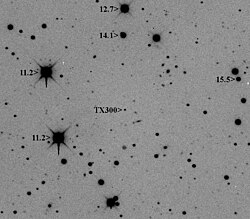2002 TX300
| 2002 TX300 | |
(c) I, Kevin Heider, CC BY-SA 3.0 2002 TX300 i ett 24-tumsteleskop, med skenbar magnitud 19,4 | |
| Upptäckt | |
|---|---|
| Upptäckare | NEAT |
| Upptäcktsdatum | 15 oktober 2002 |
| Beteckningar | |
| MPC-beteckning | 2002 TX300 |
| Alternativnamn | (55636) 2002 TX300 |
| Småplanetskategori | cubewano[1] |
| Omloppsbana[2] | |
| Epok: 21 januari 2022 | |
| Aphelium | 48,97 AU |
| Perihelium | 38,02 AU |
| Halv storaxel | 43,50 AU |
| Excentricitet | 0,1258771 |
| Siderisk omloppstid | 286,86 år |
| Medelomloppshastighet | 4,516 km/s |
| Medelanomali | 77,47° |
| Inklination | 25,83° |
| Longitud för uppstigande nod | 324,4° |
| Periheliumargument | 342,7° |
| Månar | 0 |
| Fysikaliska data | |
| Dimensioner | 709 km |
| Massa | 1.6–3.7 × 1020? kg |
| Medeldensitet | 2.0? g/cm³ |
| Ytgravitation (ekvatorn) | 0.15–0.20? m/s² |
| Flykthastighet | 0.28–0.37? km/s |
| Synodisk rotationsperiod | 8,12[4] h |
| Albedo | >0,19 |
| Temperatur | <41 K |
| Spektraltyp | (neutral) B-V=0.63; V-R=0.36[3] |
| Absolut magnitud (H) | 3,56[2] |
| Hitta fler artiklar om astronomi med | |
2002 TX300 är ett objekt i Kuiperbältet, som ligger utanför Neptunus bana. Det upptäcktes 2002 och tillhör den starkt reflektiva Haumeafamiljen av objekt i Kuiperbältet. Att de är bland de mest ljusreflekterande objekten i solsystemet beror på att de är rika på is från vatten.[5]
Referenser
- ^ ”List of Known Trans-Neptunian Objects”. http://www.johnstonsarchive.net/astro/tnoslist.html. Läst 11 oktober 2008.
- ^ [a b] Minor Planet Center Queries, uppdaterad 29 januari 2022.
- ^ A. Doressoundiram; N. Peixinho; C. Doucet; O. Mousis; M.A. Barucci; J.M. Petit och C. Veillet. ”The Meudon Multicolor Survey (2MS) of Centaurs and Trans-Neptunian objects: extended dataset and status on the correlations reported”. Icarus. Arkiverad från originalet den 28 februari 2008. https://web.archive.org/web/20080228112214/http://calys.obspm.fr/~pcorps/TNO/publi/doressoundiram2004_final_2MS.pdf.
- ^ NASA JPL Small-Body Database Browser on 2002 TX300. Läst den 13 februari 2013.
- ^ ”Size and albedo of Kuiper belt object 55636 from a stellar occultatio”. Size and albedo of Kuiper belt object 55636 from a stellar occultatio. Macmillan Publishers Limite. http://www.dtic.mil/cgi-bin/GetTRDoc?AD=ADA541934&Location=U2&doc=GetTRDoc.pdf. Läst 31 mars 2012.
| |||||||||||||||||||||||||||||||||||||||||||||||||||||||||||
Media som används på denna webbplats
Major Solar System objects. Sizes of planets and Sun are roughly to scale, but distances are not. This is not a diagram of all known moons – small gas giants' moons and Pluto's S/2011 P 1 moon are not shown.
(c) I, Kevin Heider, CC BY-SA 3.0
8 minute exposure of dwarf planet candidate (55636) 2002 TX300 with a 24" telescope. TX300 is about apparent magnitude 19.4 in this image taken at 2009-11-16 04:15 UT. The two blooming stars on the left are magnitude 11.2. TX300 is about 1,900 times fainter than the blooming stars and is approaching the limiting magnitude of a 8 minute ccd photo with a 24" telescope. For comparison the apparent magnitude of some of the stars are labeled.


